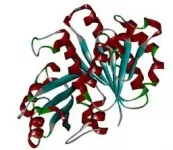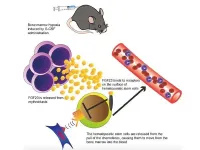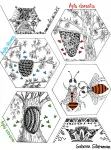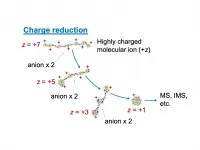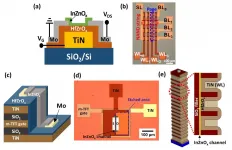(Press-News.org) Overview:
The research team of the Department of Computer Science and Engineering at the Toyohashi University of Technology and the Institute of Food Biotechnology and Genomics at the National Academy of Sciences of Ukraine have proposed a new drug to treat tuberculosis (TB), utilizing the state-of-the-art molecular simulations. This drug may inhibit the cell division of Mycobacterium tuberculosis (M. tuberculosis) and suppress its growth. In addition, because this drug acts on the enzymes secreted by M. tuberculosis instead of acting on M. tuberculosis itself, M. tuberculosis has very little chance of mutation and develops no drug resistance. Therefore, it is expected that this drug will lead to a novel drug that will keep its effectiveness for a long time.
Details:
Currently, the global spread of COVID-19 caused by the novel coronavirus has become a major social issue. Similarly, TB caused by M. tuberculosis is also one of the most dangerous infectious diseases in the world to date, and various drugs used to treat TB have been developed. However, as the M. tuberculosis easily mutates, its new mutants have a possibility to retain a resistance against the existing drugs, resulting in making them ineffective. This fact is a major bottleneck to further development of TB drugs.
Therefore, to prevent the occurrence of this drug resistance, drugs that act on the enzymes secreted by M. tuberculosis instead of M. tuberculosis itself are being developed. In this research, we targeted the cytoskeletal protein FtsZ, which is essential for M. tuberculosis to perform cell division, and by inhibiting that function, we aimed to develop a new drug that inhibits the cell division of M. tuberculosis and suppresses its growth. For this purpose, we used the state-of-the-art and high-precision molecular simulation method developed by our research group to analyze the binding properties between FtsZ and the various compounds that are drug candidates. Based on the results simulated, we proposed the compound that binds more strongly to FtsZ as a new drug to treat TB.
Development Background:
Master's student and lead author of this paper, Shohei Yamamoto, reflects on that time below. "Because the FtsZ protein targeted in this research has many positions where compounds can bind to it, we had difficulty identifying the positions of the FtsZ protein in which the compounds considered as drug candidates would bind most strongly in the molecular simulation. I think that being able to solve this matter led to the proposal of a therapeutic drug for TB."
In addition, the research team's leader, Associate Professor Noriyuki Kurita, recounts how the research began below. "This research is a collaboration with my old friends at the National Academy of Sciences of Ukraine. I remember about five years ago, when I visited a laboratory in Kyiv, Ukraine and was first introduced to a protein called FtsZ, I answered that its structure was too complex and that it would be difficult to investigate its binding properties with drug-like compounds in our molecular simulations. However, my friends asked me several times to start the calculations, and finally our intimate collaboration study started. I think that Eastern European researchers tend to thoroughly pursue difficult research themes even if it takes a long time, and that there are many things that we could learn from how they proceed with their research."
Future Outlook:
Currently, we are requesting that the compound proposed in this paper be synthesized in a Ukrainian laboratory and the effects be investigated by cell experiments, but due to the economic situation of the other party, it seems that this will take time to realize. In addition, the molecular simulation method used in this research can be applied to other proteins, and we are currently conducting calculations with the aim of proposing new inhibitors for the proteins of the novel coronavirus.
This research was carried out through an international internship program supported by the Japan Student Services Organization (JASSO), student exchange and research exchange programs between the Toyohashi University of Technology and the Institute of Food Biotechnology and Genomics at the National Academy of Sciences of Ukraine. We would like to thank Professor Yaroslav Blume, Professor Sergey Shulga, and Doctor Karpov Pavel of the National Academy of Sciences of Ukraine for providing valuable information in advancing this joint research.
INFORMATION:
Reference:
"Design of potent inhibitors against bacterial cell-division protein FtsZ: molecular docking and ab initio molecular orbital calculations", Yamamoto, S.; Saito, R.; Nakamura, S.; Sogawa, H.; Karpov, P.; Shulga, S.; Blume, Y.; Kurita, N., Antibiotics, 2020, 9, 846; doi:10.3390/antibiotics9120846.
"Binding sites of Zantrin inhibitors to the bacterial cell division protein FtsZ: molecular docking and ab initio molecular orbital calculations", Sogawa, H.; Sato, R.; Suzuki, K.; Tomioka, S.; Shinzato, T.; Karpov, P.; Shulga, S.; Blume, Y.; Kurita, N., Chemical Physics, 2020, 530, 110603.
"The real voyage of discovery consists not in seeking new landscapes, but in having new eyes."
Scientists would vouch for this statement because scientific pursuit has the habit of offering chance discoveries if we think about things differently.
In the lab of Arati Ramesh at the NCBS, the team loves to spy on the structure and sequence of Ribonucleic acids (RNAs; molecules that decrypt an organism's genetic code into protein messages). During one such instance, graduate students in Arati's lab were peering at a family of nickel and cobalt (NiCo RNAs) sensing bacterial RNAs that have a clover leaf-like structure. ...
A Kobe University research group including graduate student ISHII Shinichi and Associate Professor KATAYAMA Yoshio (both of the Department of Hematology, Graduate School of Medicine) have discovered that fibroblast growth factor-23 (FGF23) produced by erythroblasts (cells that are the precursors of red blood cells) promotes the movement (mobilization) of hematopoietic stem cells (*1) into the peripheral blood. Up until now, FGF23 has been known for the role it plays in the kidneys as a hormone which regulates phosphate concentrations throughout the body.
It is hoped that this discovery will enable new strategies to be developed for harvesting hematopoietic ...
It is early in the morning. Ebi and his colleagues try not to twitch as they stare intently at a rectangular box filled with sugary treats. These aren't for them, but for the honey bees that they study. The tiny buzzers toggle between the sugar 'feeder' and the hive, which are a few metres apart. Interestingly, the bees that visit the feeder aren't secretive about this new found food source. They graciously advertise its location to their nest mates and over time more bees are seen buzzing to the feeder.
This behavior has been observed and researched for decades; but still, the question of how bees communicate within the noisy quarters ...
Mass spectrometers (MS) have become essential tools in chemistry and biology laboratories. The ability to quickly identify the chemical components in a sample allows them to take part in a diverse array of experiments, including radiocarbon dating, protein analysis, and monitoring drug metabolism.
MS instruments work by giving the analyte molecules an electric charge, and shooting them through a region of space with a uniform electric field, which curves their trajectory into a circle. The radius of the circle, which depends on the ratio of the molecule's mass to its charge, is detected and compared with known samples. Because the method can only measure this ratio, not the mass itself, excess charges can lead to inaccurate or ambiguous results.
Now, a team of researchers lead ...
"Stripy zebra, spotty leopard, ...". Kids never become bored pinpointing animals based on their unique body patterns. While it is fascinating that living creatures develop distinct patterns on their skin, what may be even more mysterious is their striking similarity to the skin of frozen liquid metals.
Pattern formation is a classic example of one of nature's wonders that scientists have pondered for centuries. Around 1952, the famous mathematician Alan Turing (father of modern computers) came up with a conceptual model to explain the pattern formation process of a two-substance system. Such patterns are also called Turing patterns thereafter.
Pattern formation is also commonly adopted by manmade systems and this is especially true in the ...
Fungi are among the world's oldest and most tenacious organisms. They are now showing great promise to become one of the most useful materials for producing textiles, gadgets and other construction materials. The joint research venture undertaken by the University of the West of England, Bristol, the U.K. (UWE Bristol) and collaborators from Mogu S.r.l., Italy, Istituto Italiano di Tecnologia, Torino, Italy and the Faculty of Computer Science, Multimedia and Telecommunications of the Universitat Oberta de Catalunya (UOC) has demonstrated that fungi possess ...
The compulsory collection of DNA being undertaken in some parts of the world is not just unethical, but risks affecting people's willingness to donate biological samples and thus contribute to the advancement of medical knowledge and the development of new treatments, says a paper in the European Journal of Human Genetics, published online* today [18 January 2021].
Citing abuses being carried out in China, Thailand, and on the US/Mexico border, the authors1 call on scientific journals to reexamine all published papers based on databases that do not meet accepted standards of ethical approval, and demand an end to collaborations between academic institutions worldwide and those in countries carrying out unethical DNA collections. ...
As we enter the era of superintelligence and hyper-connected Fourth Industrial Revolution, the importance of high-density and high-performance memory is greater than ever. Currently, the most widely used NAND flash memory has issues of high power consumption, slow operation speed, and vulnerability to repetitive use since it relies on the charge trap effect to store information. To this, a POSTECH research team has recently demonstrated a ferroelectric memory that exceedingly surpasses the performance of the conventional flash memory in terms of operation speed, power consumption, and device reliability.
A POSTECH research team - led by Professor Jang-Sik Lee, and Ph.D. candidates Min-Kyu Kim and Ik-Jyae Kim of the Department ...
Maxwell equations govern the evolution of electromagnetic fields with light being a particular solution of these equations in spaces devoid of electric charge. A new study published in EPJ C by Alexei Morozov and Nikita Tselousov, from the Moscow Institute of Physics and Technology and the Institute of Transmission Problems, Russia, respectively, details peculiar solutions to the Maxwell equations--so-called Maxwell knots. The research could have applications in the fields of mathematical physics and string theory.
"We usually think of light as the plane waves. It was a breakthrough when ...
Two giant radio galaxies have been discovered with South Africa's powerful MeerKAT telescope. These galaxies are thought to be amongst the largest single objects in the Universe. The discovery has been published today in Monthly Notices of the Royal Astronomical Society.
Whereas normal radio galaxies are fairly common, only a few hundred of these have radio jets exceeding 700 kilo-parsecs in size, or around 22 times the size of the Milky Way. These truly enormous systems are dubbed 'giant radio galaxies'.
Despite the scarcity of giant radio galaxies, the authors found two of these cosmic beasts in a remarkably small patch of sky.
Dr Jacinta Delhaize, a Research Fellow at the ...
